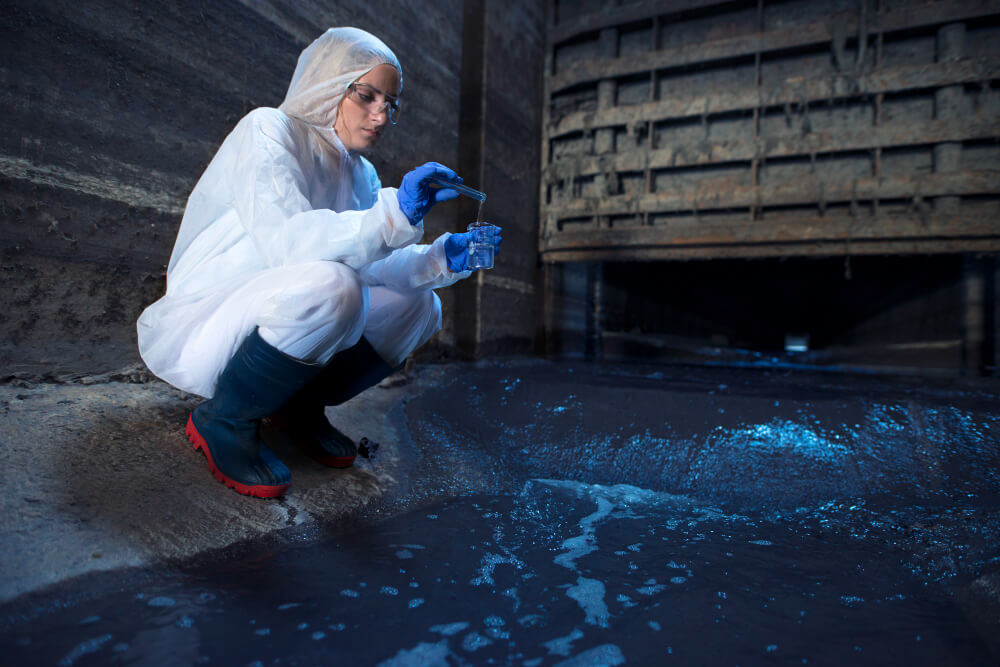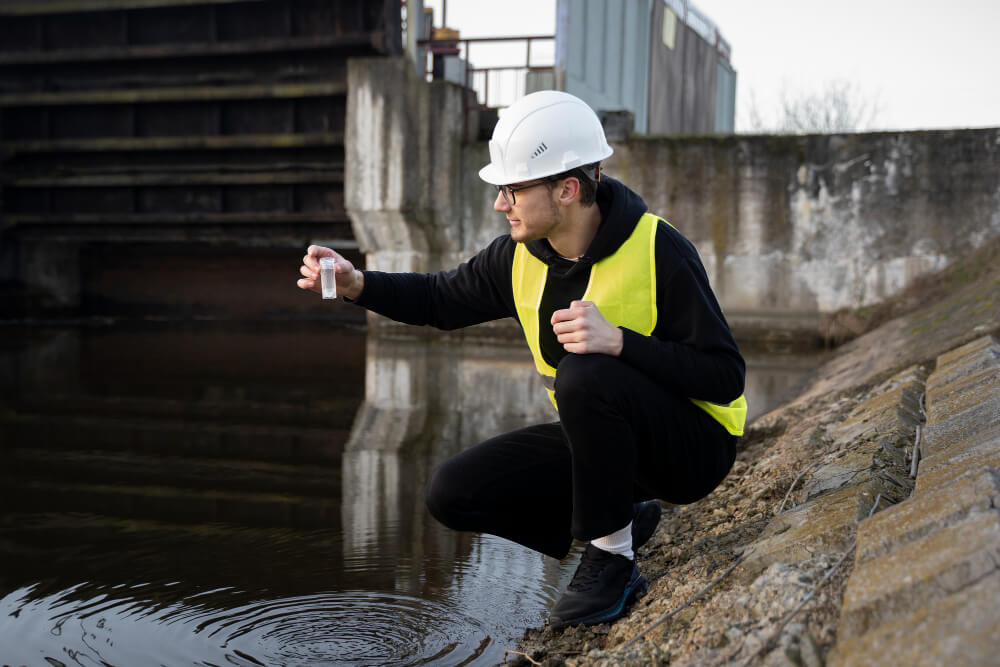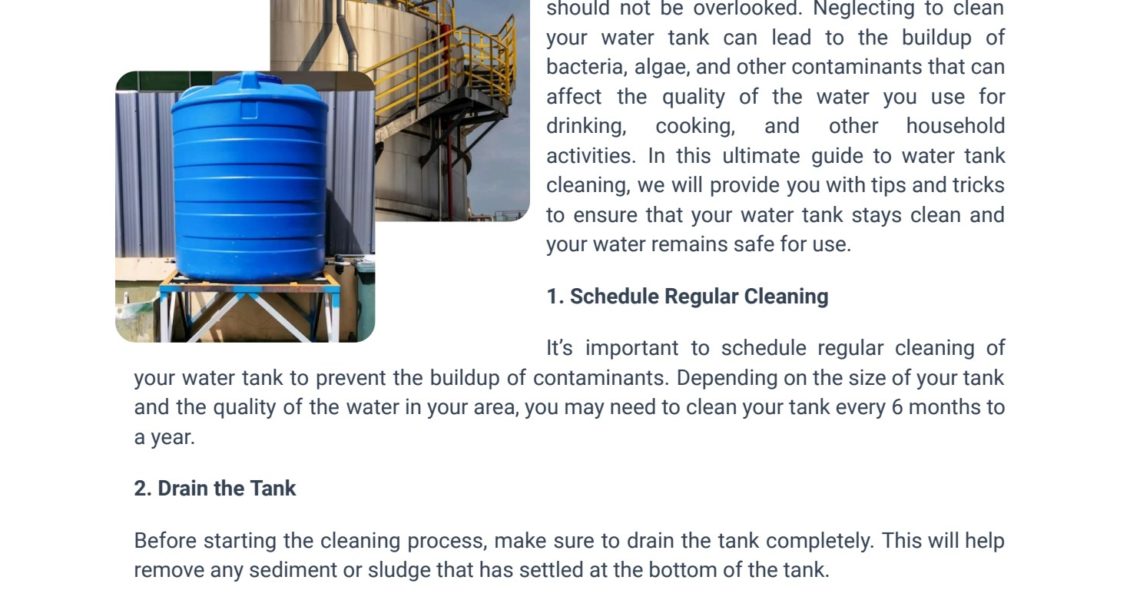The Ultimate Guide to Water Tank Cleaning in Waikato

If you live in Waikato and rely on a water tank for your household or farm, you know how crucial it is to keep it clean.
Clean water isn’t just about taste; it’s about health and safety.
This guide will address common questions and concerns about water tank cleaning in Waikato, using everyday language and relatable examples to make the process straightforward and stress-free.
Why is Water Tank Cleaning Important?
Maintaining a clean water tank is essential for several reasons:
- Health and Safety: Over time, tanks can accumulate dirt, bacteria, algae, and other contaminants that can make water unsafe to drink or use. Regular cleaning ensures the water stays safe for your family, pets, and plants.
- Efficiency: A clean tank works better. Sediment and grime can clog pipes and pumps, reducing the efficiency of your water system. This can lead to increased energy consumption and higher maintenance costs.
- Longevity: Regular maintenance, including cleaning, extends the life of your water tank. It prevents rust and damage that can occur from neglect. A well-maintained tank can serve you efficiently for many years, saving you the cost of early replacement.
Common Questions about Water Tank Cleaning in Waikato
How often should I clean my water tank?
For most households, an annual cleaning is sufficient. However, several factors might necessitate more frequent cleanings:
- Water Quality: If you notice a change in water quality, such as an unusual taste or odor, it’s a good idea to clean your tank more frequently.
- Environment: If your tank is exposed to heavy foliage, bird droppings, or other external contaminants, consider more regular cleanings.
- Usage: Higher water usage can stir up sediment more quickly, requiring more frequent cleanings.
Can I clean my water tank myself, or should I hire a professional?
This depends on the size of your tank and your comfort level with DIY tasks. Smaller tanks can often be cleaned by homeowners following proper safety guidelines.
For larger tanks or if you’re unsure, hiring a professional ensures thorough cleaning and inspection.
What are the signs that my water tank needs cleaning?
Keep an eye out for the following indicators:
- Murky Water: If the water looks cloudy or dirty.
- Unusual Smells: Any odd odors coming from your water.
- Sediment Build-Up: Visible sediment or slime at the bottom or sides of the tank.
- Health Symptoms: Increased occurrences of gastrointestinal issues among household members.
DIY Water Tank Cleaning: Step-by-Step
Cleaning your water tank might sound daunting, but with the right approach, it can be manageable. Here’s a detailed guide to help you through the process:
- Turn off the water supply: Ensure no water is entering the tank during cleaning. Locate the valve or pump switch and turn it off.
- Drain the tank: Completely empty the tank to start fresh. Use a hose or a pump to remove all the water. Be sure to dispose of the water in a manner that doesn’t flood your yard or cause erosion.
- Scrub the interior: Use a long-handled brush and a mild detergent to scrub the walls and floor of the tank. Avoid harsh chemicals that could contaminate your water. Wear gloves and possibly a mask to protect yourself from mold and bacteria.
- Rinse thoroughly: Make sure all detergent and dirt are washed out completely. Use clean water to rinse multiple times until the water runs clear.
- Inspect for damage: Check for any cracks, rust, or damage. Address any issues before refilling the tank. Small cracks can often be repaired with a waterproof sealant, while larger issues may require professional help.
- Refill the tank: Once clean and inspected, refill the tank with freshwater. Turn on the water supply and ensure everything is functioning properly.
Tips for Effective DIY Cleaning:
- Safety First: Always use protective gear to avoid exposure to harmful substances.
- Use Proper Tools: A sturdy brush, a non-toxic cleaning agent, and a reliable pump or hose are essential.
- Enlist Help: If the tank is large or the cleaning task is overwhelming, don’t hesitate to ask for help from a friend or family member.

Professional Water Tank Cleaning Services in Waikato
For larger tanks or those who prefer professional help, Waikato has several reliable service providers. Professional cleaners have the tools and expertise to ensure your tank is spotless and functioning optimally.
Advantages of Hiring Professionals:
- Expertise: Professionals have the knowledge and experience to handle various types of tanks and contamination.
- Equipment: They use specialized tools and cleaning agents that are more effective than typical household supplies.
- Thoroughness: A professional cleaning service will often include an inspection to identify potential issues that might be missed by the untrained eye.
How to Choose the Right Water Tank Cleaning Service:
When looking for a professional service, consider the following:
- Reputation: Look for reviews and ask for recommendations from friends or neighbors. Reliable companies often have positive feedback and a solid reputation in the community.
- Experience: Choose a company with a solid track record in tank cleaning. Experienced providers are more likely to deliver thorough and efficient services.
- Cost: Get quotes from a few providers to ensure you’re getting a fair price. Remember that the cheapest option isn’t always the best; consider the value for money.
- Certifications: Ensure the company follows local regulations and standards for water tank cleaning.
Keeping Your Water Tank Clean
Regular maintenance is key to a clean water tank. Here are some tips to keep your tank in good shape between cleanings:
- Install a Filtration System: This can help reduce the amount of sediment and debris entering your tank. Filters can be installed at various points in your system to catch contaminants before they enter your tank.
- Cover Your Tank: Keep your tank covered to prevent debris and pests from getting in. A secure lid can prevent leaves, insects, and other contaminants from falling into the water.
- Regular Inspections: Periodically check your tank for signs of wear and tear. Look for cracks, rust, and other damage that could compromise your water quality.
- Use Water Treatment Tablets: These can help control bacteria and algae growth. Make sure to use products that are safe for potable water.
Seasonal Maintenance Tips:
- Spring and Summer: These seasons often bring more debris and pollen. Check and clean your tank filters more frequently during these months.
- Fall: Clear away any fallen leaves and organic matter from around your tank. Ensure that your tank cover is secure to prevent leaves from entering.
- Winter: Inspect your tank for any signs of freezing or damage from cold weather. Ensure your tank is adequately insulated if it’s above ground.
Real-Life Example: Sarah’s Story
Sarah, a resident of Waikato, shares her experience with water tank cleaning:
*”Last year, I noticed our water had a strange taste and smell. I initially ignored it, thinking it was just a minor issue. However, it persisted, and eventually, I decided to check the tank. To my horror, I found a thick layer of sludge at the bottom. It was then I realized the importance of regular cleaning.
I decided to clean the tank myself. Following a guide similar to this one, I drained the tank, scrubbed it thoroughly, and refilled it. The difference was immediately noticeable. The water was clear, and the unpleasant taste and smell were gone. Now, I make sure to clean our tank every year and keep an eye on the water quality. It’s made a huge difference to our household.”*
Sarah’s story highlights how easy it is to overlook the importance of tank maintenance until a problem arises. Regular cleaning can prevent such issues and ensure your water remains safe and clean.
Encouraging Reader Interaction
Got any questions or tips on water tank cleaning? Share your experiences in the comments below! We’d love to hear your stories and advice.
If you found this guide helpful, why not share it with your friends and family in Waikato? Clean water is something everyone can benefit from.
Conclusion
Clean water is vital for your health and well-being.
By understanding the importance of regular water tank cleaning and knowing how to do it yourself or choose the right professional, you can ensure that your water supply remains safe and reliable.
Regular updates to this guide will keep it relevant and useful.
As new techniques and products become available, incorporating them can help readers stay informed and maintain their tanks more effectively.
Staying proactive about water tank maintenance is not just a chore but a step towards a healthier lifestyle.
Enjoy the benefits of fresh, clean water all year round!
FAQs
How often should I clean my water tank?
It is recommended to clean your water tank every 6 months in the Indian environment. The WHO advises cleaning tanks once every 3 months. However, the exact frequency depends on factors like whether the tank is in a sunny or shaded area, if it stores hard or soft water, and the water turnover rate.
What is the process for cleaning a water tank?
The typical steps are:
- Drain the tank completely
- Scrub the interior surfaces with a cleaning solution (detergent, bleach, or mild soap mixed with water)
- Rinse the tank thoroughly with clean water
- Disinfect the tank and pipes with an antibacterial spray or liquid bleach
- Test the water quality and repeat cleaning if needed
Do I need to hire a professional to clean my tank?
While cleaning a standard small tank can be done yourself, it’s best to hire a professional for larger tanks. Professionals have the right equipment and expertise to clean tanks efficiently and safely, especially if the tank is elevated or requires full drainage and sludge removal.
What equipment is needed for cleaning a water tank?
- Useful equipment includes:
- Extendable brushes with adjustable heads
- High-pressure hoses or water jets for scrubbing and rinsing
- Wet vacuums for removing residual water
- Appropriate personal protective equipment
How can I maintain my water tank between cleanings?
Some tips:
- Keep the tank covered to prevent debris and sunlight from entering
- Ensure the tank is located in a shaded area if possible
- Avoid letting water stagnate for long periods
- Regularly check for any cracks, leaks or other damage
By following these guidelines and getting your water tank cleaned at the recommended intervals, you can help ensure the water quality remains high and the tank lasts for many years. Let me know if you have any other questions!





